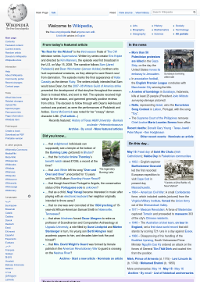In this tutorial you will learn how to easily convert web pages and raw HTML
documents to PDF in your PHP applications. We will use the
Pdfcrowd API for PDF generation. The API offers
these benefits:
The API is easy to use and fully supports HTML/CSS3/JavaScript.
The integration takes only a few minutes.
No third-party libraries are needed, just a single tiny PHP file.
It does not consume CPU/memory on your computer, PDFs are created on the Pdfcrowd servers.
Introduction
Let's start with an example:
require 'pdfcrowd.php';
$client = new \Pdfcrowd\HtmlToPdfClient("username", "apikey");
$pdf = $client->convertUrl('https://en.wikipedia.org/');
?>
This code converts en.wikipedia.org and stores the generated PDF to a string
variable. You can save the result to a file or you can stream it to the browser,
which we will discuss in detail shortly. You can click the thumbnail to open the
generated PDF file:

Besides web pages, you can also convert a local HTML file or an HTML string:
$pdf = $client->convertFile('/path/to/your/file.html');
$pdf = $client->convertString('bold and italic');
?>
It is also possible to save the PDF directly to a file:
$client->convertUrlToFile('http://example.com/', 'example.pdf');
?>
Basic Customization
Now that you know the basics, you may want to customize the generated PDF. Let's
change the page format to Letter with half-inch margins:
$client->setPageSize("Letter");
$client->setPageMargins("0.5in", "0.5in", "0.5in", "0.5in");
?>
You can use metric units as well:
$client->setPageMargins("1cm", "1cm", "10mm", "10mm");
?>
You can also specify the appearance of the PDF when it is opened in a
viewer:
$client->setInitialPdfZoomType(Pdfcrowd::FIT_PAGE);
$client->setPageLayout(Pdfcrowd::CONTINUOUS);
?>
The API provides many other options including password protection and fully
customizable page headers and footers. Learn more about the available options in
the HTML to PDF API - PHP SDK
documentation.
Server Side PDF Generation
In this section we will show two common PDF generation scenarios.
Generate PDF and send it to the browser
The following code converts example.com to PDF and sends it as a
response:
require 'pdfcrowd.php';
try {
$client = new \Pdfcrowd\HtmlToPdfClient("username", "apikey");
$pdf = $client->convertUrl("https://example.com.com/");
header("Content-Type: application/pdf");
header("Cache-Control: no-cache");
header("Accept-Ranges: none");
header("Content-Disposition: inline; filename=\"example.pdf\"");
echo $pdf;
}
catch(\Pdfcrowd\Error $why) {
fwrite(STDERR, "Pdfcrowd Error:{$why}\n");
}
?>
To convert an HTML string you can use convertString() instead of convertUrl():
$pdf = $client->convertString("
....");?>
Since Content-Disposition is set to inline the generated PDF is opened in the
browser. If you change it to attachment the browser will pop up the file
download dialog:
header("Content-Disposition: attachment; filename=\"mydomain.pdf\"");
?>
Provide a PDF version of your web pages
This example shows how to enhance your PHP code so it can return a PDF
version of your web pages. Let's look at the following helper function:
require 'pdfcrowd.php';
function generatePDF()
{
if (!$_GET["pdf"])
return False;
try {
// build the url and remove the pdf field from the query string
$url = "http://" . $_SERVER["SERVER_NAME"] . $_SERVER["PHP_SELF"];
if (count($_GET) > 1) {
unset($_GET["pdf"]);
$url = $url . "?" . http_build_query($_GET, '', '&');
}
// call the API
$client = new \Pdfcrowd\HtmlToPdfClient("username", "apikey");
$pdf = $client->convertUrl($url);
// send the generated pdf to the browser
header("Content-Type: application/pdf");
header("Cache-Control: no-cache");
header("Accept-Ranges: none");
header("Content-Disposition: attachment; filename=\"created.pdf\"");
echo $pdf;
}
catch(\Pdfcrowd\Error $why) {
fwrite(STDERR, "Pdfcrowd Error:{$why}\n");
}
return True;
}
?>
The generatePDF() function first checks if there is a pdf field in the query
string. If yes, then the field is removed from the url. The function then passes
the modified url to the API and finally sends the generated PDF to the browser.
You can use the function in your code like this:
if (generatePDF())
return;
// your HTML rendering code
// ...
?>
https://mydomain.com/page.php?pdf=1 now returns a PDF version of
https://mydomain.com/page.php.





















 9381
9381











 被折叠的 条评论
为什么被折叠?
被折叠的 条评论
为什么被折叠?








